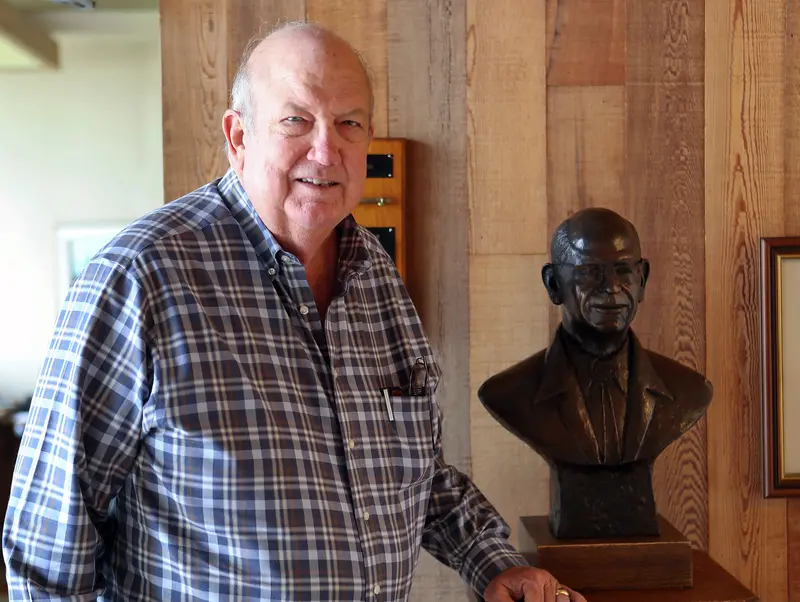ProPublica is a nonprofit newsroom that investigates abuses of power. Sign up for Dispatches, a newsletter that spotlights wrongdoing around the country, to receive our stories in your inbox every week. This story was co-published with The Desert Sun.
Craig Elmore’s family history is the stuff of Westerns. His grandfather, John Elmore, a poor son of a Missouri preacher, arrived in California’s Imperial Valley in 1908 and dug ditches to deliver water to homesteaders.
Thanks to his marriage to a citrus magnate’s daughter, reputed good fortune as a gambler and business acumen, he amassed the Elmore Desert Ranch, part of roughly 12,000 acres that two branches of the family still farm.
All that land in the blazing-hot southeastern corner of California came with a huge bonanza: water from the Colorado River. In 2022, the present-day Elmores consumed an estimated 22.5 billion gallons, according to a Desert Sun and ProPublica analysis of satellite data combined with business and agricultural records. That’s almost as much as the entire city of Scottsdale, Arizona, is allotted.
That puts the Elmores in exclusive company. They are one of 20 extended families who receive fully one-seventh of the river’s flow through its lower half — a whopping 1,186,200 acre-feet, or about 386.5 billion gallons, the analysis showed.
The Colorado River system, which supplies 35 million people in seven U.S. states and Mexico, nearly collapsed last year. Even after a wet winter, it is dwindling due to overuse and climate change. But no matter how low its reservoirs sink, the historic claims of these families and all of Imperial County place them first in line — ahead of every state and major city — for whatever water remains.
How a handful of families and a rural irrigation district came to control so much of the West’s most valuable river is a story of geography and good timing, intermarrying and shrewd strategy, and a rich but sometimes ugly past when racist laws and wartime policies excluded farmers of color. Together, they winnowed the greatest access to these 20 clans, who today use more of the river than all of Wyoming, New Mexico or Nevada. A vast, laser-leveled green quilt of crops covers this naturally bone-dry valley, all of it grown with Colorado River water.
The water is held “in trust” by the Imperial Irrigation District and two smaller agencies, meaning they are legally required to deliver the water to any county landowner for use on their property.
But many farmers here see the river water as virtually their private property, though nearly all acknowledge it can’t be sold apart from their land.
“It’s not a public resource,” says Rachel Magos, executive director of the Imperial County Farm Bureau. “It’s called prior perfected rights.”
That phrase, “prior perfected rights,” is shorthand for legal decisions spanning 100 years, including three by the U.S. Supreme Court, that have perpetuated those rights since early would-be developers staked claims for the Imperial Valley that amounted to the river’s entire flow.
Blood ties, and the ceaseless buying of lands from less successful farmers or descendants who want a “windfall,” have concentrated thousands of farm fields and the water that comes with them into an ever-smaller number of hands, says county tax assessor Robert Menvielle.
Menvielle, a third-generation resident, and his extended family own about 1,700 acres that they largely lease to farmers, some of whom he’s known his entire life. “You’ve got this small group of families, and … they’ve all intermarried, and it’s almost like a feudal-type system, where we’re combining our little kingdoms,” he says.
Those fiefdoms exclude most of Imperial’s 180,000 residents. Agricultural operations — which in addition to historic farming families include universities, the Mormon Church, outside speculators and a Middle Eastern hay company — get 97% of the irrigation district’s river water, while every town, strip mall and other business combined get 3%. And the county ranks among the poorest in California, with a 2021 per capita income of $19,005. The U.S. per capita income that year was $70,480.
Irrigation district spokesperson Robert Schettler didn’t dispute the Desert Sun and ProPublica analysis showing who uses the valley’s water and what they do with it. But he said in a statement that despite distributing half of its water to 20 extended families, the district “provides equitable water delivery service to all,” including small landowners, towns and businesses.
The disparities in wealth and water disturbed Benny Andrés Jr. when he was growing up in Imperial County, and he became a historian partly to study their origins.
“How is it that a region conducive to year-round farming, with half a million acres of rich soil, plentiful and subsidized water … has bred widespread poverty and unhealthiness?” Andrés, now an associate professor at the University of North Carolina at Charlotte, asks in his book, “Power and Control in the Imperial Valley.” His research shows that outside speculators and absentee landlords also amassed huge amounts of land and water while people of color were systematically excluded, condemning most to eventual poverty.
Growers say that without agriculture, unemployment and poverty here would be even worse.
Meanwhile, outside threats to the area’s outsized water supply are looming. As federal officials force hard choices to keep the river afloat, states and cities facing water cuts are eyeing the Imperial Valley. The big farmers and their irrigation district say they know they’ve got a target on their backs.
Jay Famiglietti, an Arizona State University hydrologist who studies global water supplies, says large-scale farming in southwestern deserts like the Imperial Valley is “not sustainable, it just can’t go on.” Ultimately, production may need to shift to wetter regions.
Elmore and other farmers say that could devastate year-round food supplies in the U.S. — you can’t grow leafy greens and alfalfa in the Midwest in February. But they are striving to use far less water and to devise new ways to profit from an ancient flow.
Just Add Water
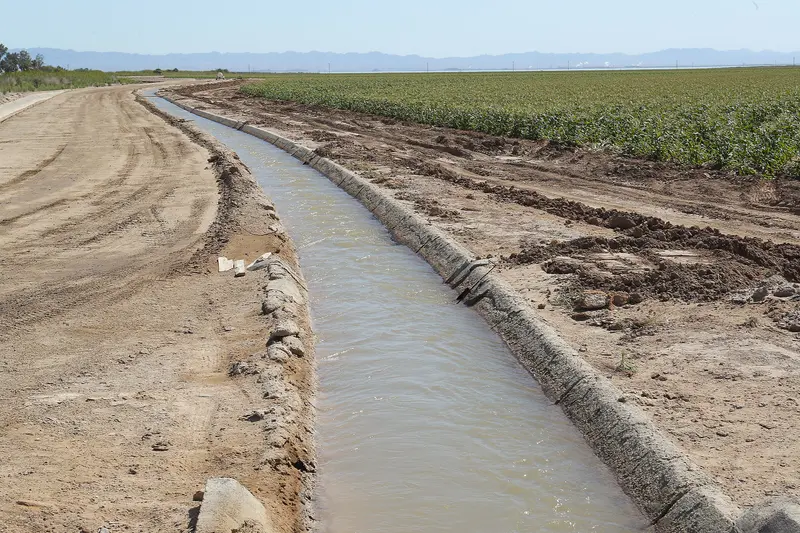
Elmore’s grandfather arrived a year after the Southern Pacific Railroad forced the then-raging Colorado River to resume its normal course to Mexico, ending two years of flooding in the valley. For eons, the river was a wild, unpredictable force that shaped this landscape. At times, it flowed west and north into a huge trough between emerging mountain ranges. Here, the ancient river deposited millions of tons of mineral-rich soil.
In the mid-1800s, physician O.M. Wozencraft, a would-be land developer, realized that if the river could be diverted into its ancient path, the silty top coat of what was then known as “the Valley of Death” could be farmed. He persuaded California to deed him most of present-day Imperial County, but he couldn’t convince Congress to pay for a canal to carry river water to his land. A congressman called the scheme a “fantastic folly of an old man.”
But the lure of that water was irresistible. From 1895 through 1899, according to M.J. Dowd’s book, “The First 40 Years,” dreamers, schemers and agents for land barons posted notices on the river’s western bank, invoking California law protecting downstream mining claims, and filed them with the county recorder. “Each of these appropriations was for a flow of 10,000 cubic feet per second of the water of the Colorado River,” writes Dowd.
Collectively, they claimed the river’s entire flow and then some, Andres says. “They wanted it all, they didn’t want Arizona or anybody else to get a drop.”
But he and other experts note such claims had to be actively worked on, by seeking investors, building infrastructure and eventually providing water for “beneficial uses.”
By 1901, the California Development Co. had acquired rights to as much water as it could use. That year, Colorado River water was diverted via the first canal to what had been grandly christened the Imperial Valley, and by 1910, thousands of small farmers had arrived. The following year, the Imperial Irrigation District was formed, and a few years later, it bought out the private company and its rights.
Restless young men from India, Japan, Europe and the eastern U.S. arrived in the next 30 years. Many quickly went belly up and sold to more successful neighbors, like ancestors of the Elmores, Abattis, Strahms, Saikhons, Taylors, Morgans, Schaffners, Grizzles, Brandts, LaBrucheries, Rueggers and Osterkamps, all among the top 20 families using Imperial water today.
No Limits
The rose-colored vision of hardy pioneers “settling” the “virgin West” — after driving Native Americans from their ancestral lands — was enshrined in the federal Homestead Act of 1862 and Reclamation Act of 1902. Farmers were permitted to occupy and irrigate a maximum of 160 acres of free land and make it their own.
However, Imperial County landowners and complaisant U.S. Bureau of Reclamation officials ignored that limit, allowing rapid consolidation of land, says Andrés, who wrote his doctoral dissertation on the county’s early years. Thousands of formerly small holdings were now “farm units” absorbed by growing spreads like the Elmores’, a cotton syndicate, and hundreds of absentee landlords, he found. A 1924 report estimated 85% of Imperial landlords lived on the California coast or out of state.
Many farmers in the county were not white: By 1922, there were 2,200 Japanese immigrants farming 28,000 acres, and 495 people from India farmed 36,000 acres. Japanese growers, some of whom had worked on Hawaiian pineapple plantations, were often highly skilled and successful across California. Similarly, immigrants from the Punjab region of India knew how to coax vegetables from the valley’s often claylike soil in triple-digit heat. Some owned land; others farmed absentee owners’ holdings.
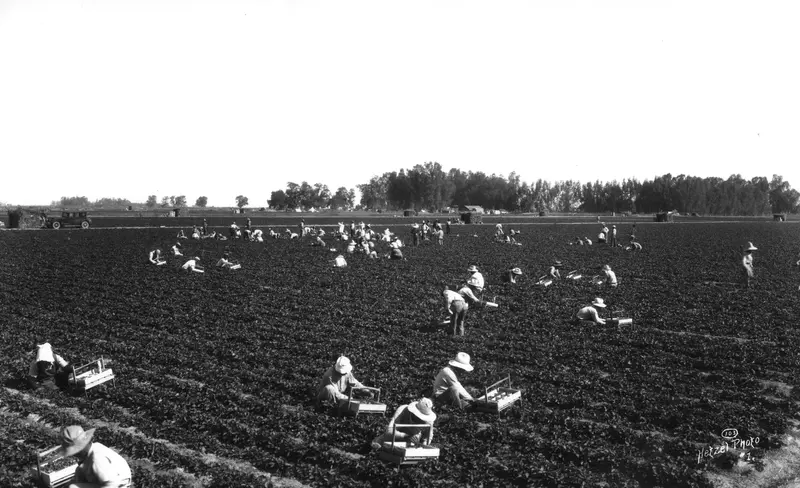

These migrants regularly endured racism. Landowners, county officials and even farmers of differing nationalities ranked migrants — Japanese, Indians, Filipinos, Mexicans and eventually Black southerners — in terms that would be familiar to white eugenicists. They classified them by their farming knowledge, ability to do backbreaking labor in searing heat and “reliability,” which meant they were unlikely to walk off the job or to demand higher wages or better living conditions.
“Like immigrants always, these groups were more desperate to succeed, so they were willing to work harder,” Andrés says.
White groups statewide decried the success of people of color. State Alien Land Laws banned Asians from owning land or leasing it long term. The U.S. Supreme Court upheld the second ban, but it was rarely prosecuted in Imperial. Still, it was not easy. Japanese families built wooden “mobile” shacks that they could carry from one set of fields to another after leases ended or if they were forcibly evacuated.
The exclusionary law drove out people of color who worked as merchants, too, and “began to depopulate the countryside,” said Andres. Many large landowners also ceased using full-time workers who lived nearby and hired contractors to bring in cheap, temporary labor from across the border.
Elmore says his grandfather operated differently than many during that era, building a school that all children from the surrounding remote area could attend. Elmore still lives in Imperial County, has about 50 full-time employees, and pays their health and life insurance benefits.
Today, instead of a vibrant local workforce, thousands of day laborers line up as early as 1 a.m. at the Mexicali-Calexico border, waiting for hours to be bused to fields, then back again. Meanwhile, Imperial had the highest unemployment rate in California in September, 19.7%, compared with 4.4% statewide.
Imperial Valley United
When the Great Depression hit, a flood of Dust Bowl “Okies” and other poor white and southern Black migrants arrived, upending the “whites first” racial caste system.
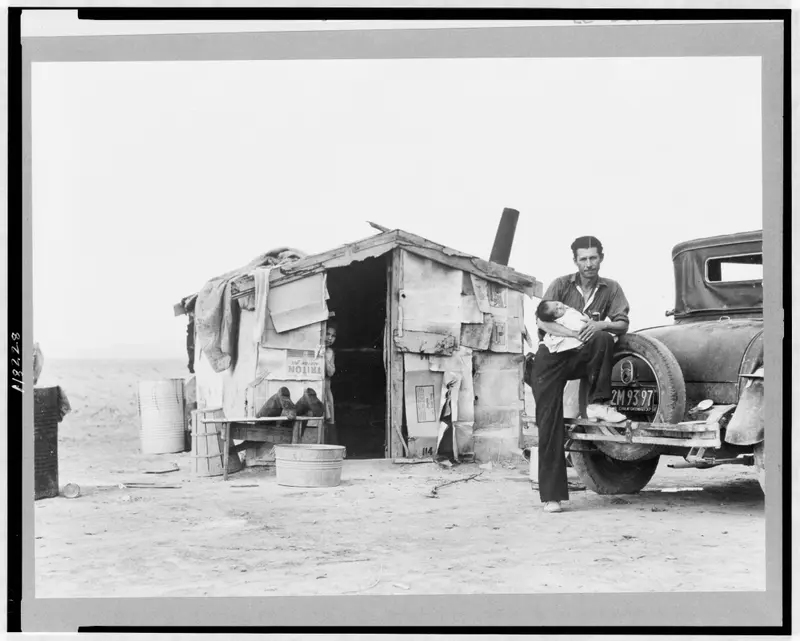
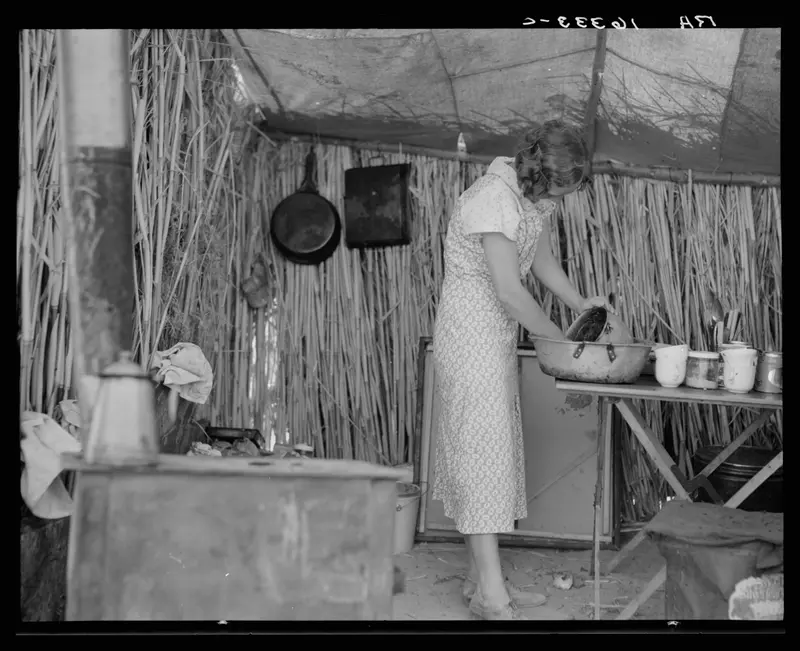
A few years later, during World War II, anti-Asian sentiment reached a fever pitch. FBI agents forced more than 100 Japanese community leaders from their homes in February 1942, including a Buddhist priest and a Christian minister. Then on two nights in May of that year, the entire Japanese population of Imperial County — hundreds of successful farmers, merchants, religious leaders and their families — was removed from their homes to be forcibly relocated to the Poston incarceration camp in Arizona. Some of the valley’s first farmers were among those imprisoned.
Their parcels, like land owned by detained Japanese farmers across the state, were likely acquired by neighbors and investors at foreclosure sales. Elmore says his grandfather and father had Japanese farmer friends who were forcibly removed. “That shouldn’t have happened,” he says. He’s not sure who acquired the local Japanese families’ land. “I know we didn’t.”
Near the end of the war, a huge anti-Japanese rally was held on the Brawley high school football field. A resolution was adopted petitioning the president, Congress and governor of California and protesting the return of any Japanese people to the Imperial Valley. Speakers at the rally condemned local churches for trying to aid their former neighbors.
There were financial motives behind the xenophobia. Powerful white shippers and growers organized the event, telling the local chamber of commerce that two people from the Poston camp “had appeared in town, announcing their intention to return to Brawley.” About 2,500 more former Imperial Valley residents of Japanese ancestry were due to be released.
A broad coalition of community groups dubbed “Imperial Valley United” vowed to permanently exclude Japanese people from the valley. Today, one Japanese-American farmer is listed on the Imperial Valley Vegetable Growers Association roster, and it’s not clear if he used any water last year.
“Prior Perfected”
Imperial officials lobbied for years for massive federal infrastructure to “tame” the Colorado and diminish the impact of drought and flooding. Growing southwestern cities wanted a steady water and power supply, too. It took until 1935 to complete what was then the world’s largest dam, in Boulder Canyon, Arizona.
In exchange for Hoover Dam, California and six other states signed a “Law of the River” compact. It divided the Colorado into upper and lower basins and set maximum amounts that each could take annually.
The Imperial Irrigation District had to agree for the first time to cap its river allocation. On paper, the era of no limits was over. But in practice, the agency would for decades order as much free river water as its farmers wanted.
There were challenges to their dominance.
As Phoenix and other cities in the Southwest grew exponentially, Arizona challenged California’s historic claim to the Colorado River. Arizona lost, but in 1960, the U.S. Supreme Court decided that California would keep 4.4 million acre-feet, Arizona would be entitled to 2.8 million acre-feet and Nevada would get 300,000 acre-feet. Imperial County came out on top, with a legal claim to three-quarters of California’s share.
An idealistic New York doctor named Ben Yellen, who had built a practice in Brawley caring for low-income residents and farmworkers, also wrote “yellow sheets,” denouncing Imperial landowners’ long-standing violation of the 160-acre homesteading limit and the irrigation district’s delivery of massive amounts of river water to them in violation of the 1902 Reclamation Act. He successfully intervened in a case challenging the water district, and California’s highest court eventually ruled the 160-acre irrigation limit had been illegally ignored.
But Elmore’s father and other major farmers fought back. In 1980, the Supreme Court ruled that the farmers could keep their large tracts and all the river water being delivered to them. The court ruled that the Imperial Irrigation District held “prior perfected” rights acquired from private irrigation companies under state law, neither of which had imposed limits on how much acreage could be irrigated. A framed copy of the decision hangs on Elmore’s ranch office wall.
U.S. Sen. Alan Cranston that year slipped language into a bill supposedly designed to reform the Bureau of Reclamation that permanently exempted Imperial County farmers from the 160-acre limit.
The number of farmers continued to shrink. From the 1960s to the 1990s, hundreds of smaller Imperial County farmers — largely descendants of Filipino migrants and other people of color — were decimated. U.S. Department of Agriculture research led to sturdier tomatoes that could be transported long distances, including from Mexico, which slashed demand for tastier but more perishable tomatoes grown by more than 500 Filipino farmers in and around Niland, in the valley. The North American Free Trade Agreement sent even more farming across the border, wiping out more small Imperial operations.
Sending Water to Cities
It was the Elmores who first cost their fellow growers some water. In 1982, Craig Elmore’s dad sued neighboring farmers and the irrigation district. The Elmores’ land sat at a lower elevation than nearly every other farmer’s fields, and they alleged that aging canals and overwatering by some had caused costly flooding on their fields.
The courts found that the irrigation district and its farmers were wasting water. The settlement agreement forced the district to partner with the urban Metropolitan Water District of Southern California, which supplies 19 million residents in coastal counties. In exchange for a cut of Imperial’s water, Metropolitan Water District funded the lining of the earthen All-American Canal and miles of side ditches.
As cities and suburbs drew millions more residents, Imperial’s power continued to erode. In 2002, President George W. Bush’s Interior secretary, Gale Norton, threatened to take some of Imperial’s water for cities; a year later, U.S. Sen. Dianne Feinstein bluntly warned Imperial Irrigation District officials that if they didn’t agree to transfer 300,000 acre-feet per year to suburban San Diego and the Coachella Valley, the U.S. Interior secretary might strip away their “senior” water rights. It would be the largest transfer of agricultural water to an urban area in the nation’s history, and the irrigation district would be paid handsomely by urban customers.
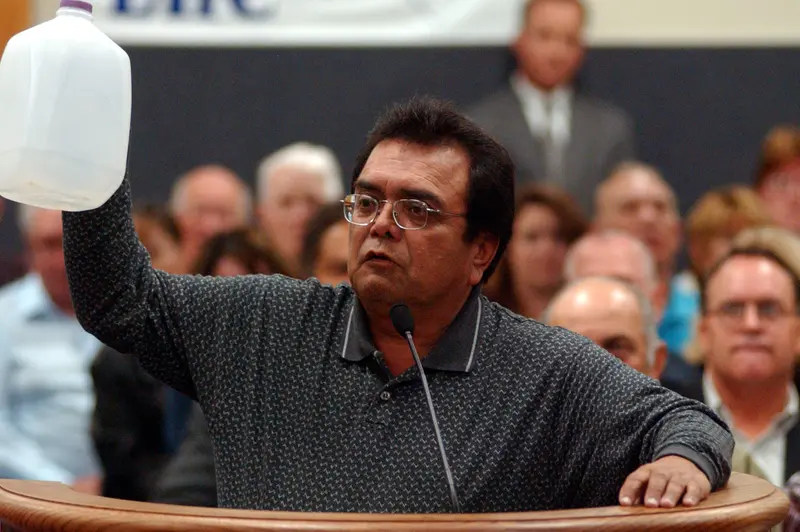
A thin majority of the district’s board approved the deal. Most farmers have now accepted that they, like everyone else, have a limit on how much water they can use. But with urban areas wielding far more political power, some are not sure there will be farming here in another century.
“We Adapt”
Ralph Strahm, who with his brother and nephews used an estimated 81,000 acre-feet of water last year, the second-highest amount in the district, thinks people’s need for drinking water may win out over the need for food in most politicians’ minds.
He and other prominent growers are willing to seasonally fallow some fields for two months during the summer, if they’re paid to do so and keep their “senior” river rights. The federal government is weighing whether to award Imperial Irrigation District and local growers more than $600 million not to farm certain fields.
Andrés, the historian, says that approach is what led to most of the county’s impoverishment. He has his own vision for the valley’s future: The irrigation district and farmers should sell less-productive or unused land and pay out of their own pockets to ensure they use water efficiently. Public funds and training should instead support the diverse group of small farmers, he says.
But Elmore says hefty public subsidies and possible private investments are needed for farmers to grow crops more efficiently, then be paid to possibly transfer the conserved water elsewhere or leave it in the river’s massive reservoirs.
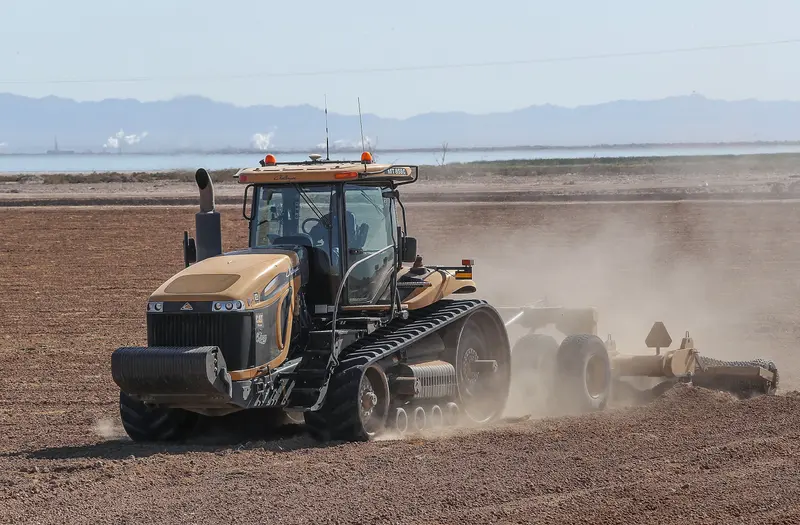
Elmore’s son is the southwest region farm manager for Water Asset Management, a Wall Street investment firm whose mission is to tap into a potential trillion-dollar water transfer market. Elmore has spoken at WAM’s annual meetings, and like another top vegetable farmer, Jack Vessey, now leases and farms acreage that WAM has bought in the valley.
Elmore is building support in the irrigation-district for funding a $4.4 million pilot reservoir on his land, which could ultimately hold water for farming or for sale. The private sale of water outside the valley is currently prohibited, but that could change if public funding for conservation dries up.
However it shakes out, the Elmores and Imperial’s other dynasties will likely continue profiting from the Colorado River.
“I’m optimistic,” Elmore says in a throaty rumble. “Every time there’s a change, we adapt. If there’s one thing the Imperial farmer has learned how to do in these harsh conditions, it’s to adapt.”
Elmore, 66, says he’s thinking about who will benefit long term: “My grandson is 6 years old. I’d like to see him go into farming.”
Nov. 10, 2023: The story originally misidentified where Jay Famiglietti works. He is at Arizona State University, not the University of Arizona.
Mark Olalde contributed reporting.
Janet Wilson’s reporting was supported by funding from Stanford University’s Bill Lane Center for the American West.
